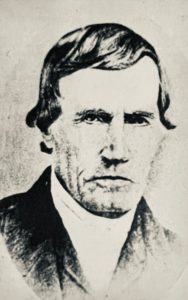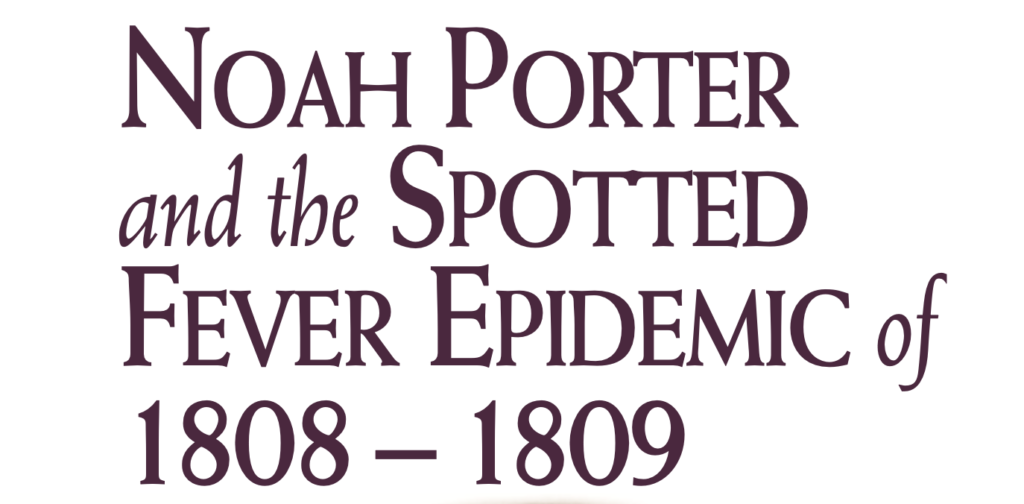(c) Connecticut Explored Inc. Winter 2021-2022
Subscribe/Buy the Issue!
 Reverend Noah Porter Jr. (1781 – 1866) was a son of a minister of the First Congregational Church in Farmington, and he also served as minister of that church from 1806 to 1866. He wrote a memoir, Half Century Discourse (Samuel S. Cowles, 1857), in which he describes the spotted fever epidemic of 1808 – 1809; an excerpt is below.
Reverend Noah Porter Jr. (1781 – 1866) was a son of a minister of the First Congregational Church in Farmington, and he also served as minister of that church from 1806 to 1866. He wrote a memoir, Half Century Discourse (Samuel S. Cowles, 1857), in which he describes the spotted fever epidemic of 1808 – 1809; an excerpt is below.
Today we recognize the epidemic disease to which Porter referred as meningococcal infection. At the time it puzzled and frightened physicians and laity by its randomness and varying manifestations. The disease could affect a single member of a household and no others. Or entire families could be wiped out. We now understand that meningococcus may have been a resident organism in 5 to 15 percent of the population and this may have resulted in at least partial immunity. But the disease often came on with shock and a quick demise.
Perhaps the best-known survivor was two-year-old Alice Cogswell. She became deaf in 1807 as a result of the disease, leading her father, Dr. Mason Cogswell, a leading physician of Hartford, to found what is known today as the American School for the Deaf.
The years 1808 and 1809 will long be remembered as years of fearful visitation. In March, 1808, the spotted fever was commissioned to visit us and others around us, a dreadful scourge, and raged till June, 1809, with the intermission of a few months in the latter part of 1808. In these two years, there were nearly seven hundred cases in which medical aid was called, and few persons altogether escaped. Persons of all ages and conditions fell before it. Many died suddenly; many from the first attack were deranged in mind; and some fell asleep not be awakened. The distress, the grief, the consternation, were not to be described. Sometimes there were hardly enough that were well to takecare of the sick, and the watchers, as they passed the streets homeward at day-dawn, saw but here and there a house in which lights were not burning. On the sabbath, for a long time, almost the whole congregation were clad in mourning, and were the families that were without father or mother. The deaths in 1808 were sixty-three, and in 1809 there were sixty-two; and about half, each year, were of the fever. For several years following, diseases were of a similar type; but until the present time we have as a people been remarkably healthful… . To the praise of his goodness and forbearance, I desire, to record it, that my wife and seven children all live. May a gracious God prepare us for the inevitable stroke.
Porter had been the beloved pastor of Farmington’s Congregational Church for 50 years when he wrote these words in 1856. He had been asked by his parishioners to write a memoir of those events. His modesty and caring are evident in his loving recollections of his congregation. Porter’s description of his experience led him to write a most vivid description of the community’s experience, which had been like no other. Who but the pastor could write with such eloquence about the impact of disease upon his little congregation? Who could write so, today, of the effects of COVID-19?
Physicians in the early 1800s had no understanding of the germ theory of infectious disease and no idea what caused this malady. The dangers of exposure and proximity were unclear and debated. It was even reported by some not to be infectious. New England physicians were also unaware that the same disease had devastated Europe’s military camps beginning about 1805. In this Puritan world, it was often said to be a manifestation of God’s wrath at sinful human behavior.
The organism that was found to have caused spotted fever was a bacterium identified in 1887 by Professor Anton Weichselbaum of the University of Vienna. It lived within cells and was difficult to cultivate. It had a great tendency to mutate. It could even change its strain by changing its protective “capsule.” This sly organism behaved oddly, persisting in some patients for years as “chronic meningococcemia.”
Nearly every town history in New England and New York mentions spotted fever and the devastation it caused in these years. The stories are dark, tragic, and terrible. The disease could progress over 12 to 24 hours in a previously well person to vascular collapse with an ugly death and a corpse of frightening appearance. All in all, this was the most intense of the many epidemics that affected New England, including the lethal smallpox and yellow fever.
Charles N. Leach Jr., M.D. was a clinical professor of medicine at the University of Connecticut School of Medicine, from which he retired in 2000. This story is based on his long interest in epidemics and his 2010 article in Farmington Historical Society News. For CTExplored, he last wrote “Fighting Smallpox at Hospital Rock,” Feb/Mar/Apr 2004.
Explore!
“Fighting Smallpox at Hospital Rock,” Feb/Mar/Apr 2004
“Spanish Flu: Ninety Days that Sickened Connecticut,” Spring 2007
GO TO NEXT STORY
GO BACK TO WINTER 2021-2022 CONTENTS

